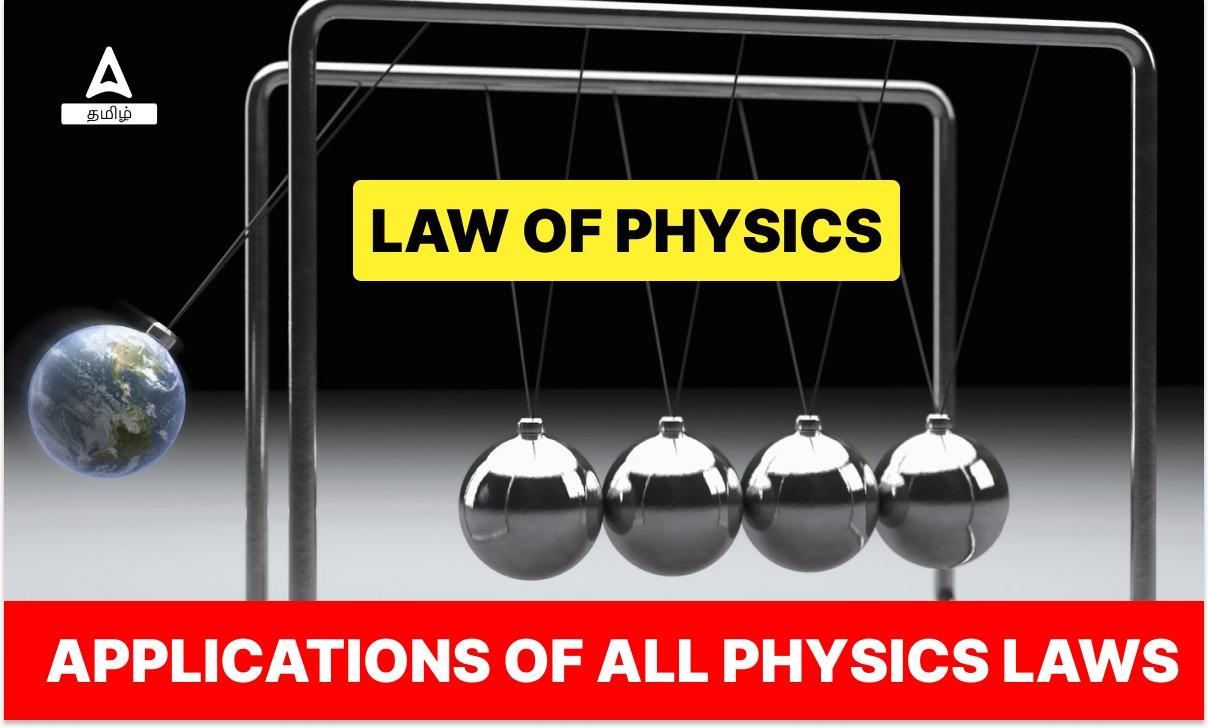Table of Contents
Laws of Physics
Laws of Physics are stated facts which have been deduced and derived based on empirical observations. Simply put, the world around us works in a certain way, and physical laws are a way of classifying that “working.” Read the article to get detailed information about Laws of Physics and Applications.
Fill the Form and Get All The Latest Job Alerts
Application of Laws of Physics
தொடக்கத்தில், பூமிதான் பிரபஞ்சத்தின் மையம் என்று கருதப்பட்டது. பின்னர் நமது சூரியன் பிரபஞ்சத்தின் மையம் என்று அனுமானிக்கப்பட்டது. இந்த இரண்டு முடிவுகளும் தவறானவை என்பதை நாம் இப்போது அறிவோம். சூரியன் நமது சூரிய குடும்பத்தின் மையமாக இருக்கலாம், ஆனால் அது பிரபஞ்சத்தின் மையம் அல்ல. மற்றொரு உதாரணம் புதன் கிரகத்தின் ஒற்றைப்படை நடத்தை. நியூட்டனின் உலகளாவிய ஈர்ப்பு விதி சூரிய மண்டலத்தில் உள்ள மற்ற அனைத்து கிரகங்களையும் விளக்க முடிந்தது, ஆனால் புதனின் சுற்றுப்பாதை மற்றும் சுழற்சி காலம் சற்று விலகி இருந்தது, ஏன் என்று யாருக்கும் தெரியவில்லை. பின்னர், ஐன்ஸ்டீன் தனது பொது சார்பியல் கோட்பாட்டின் மூலம் மீட்புக்கு வந்தார். இயற்பியல் விதிகளின் வெவ்வேறு பண்புகள் அவற்றின் இயல்பு பற்றிய தகவல்களைக் கீழே கொடுக்கப்பட்டுள்ளன:
1.உண்மை, குறிப்பிட்ட நிபந்தனைகளின் கீழ்
2.உலகளாவிய மற்றும் பிரபஞ்சத்தில் எங்கும் விலகாதே
3.பிரதிநிதித்துவத்தின் அடிப்படையில் எளிமையானது
4.முழுமையான மற்றும் வெளிப்புற காரணிகளால் பாதிக்கப்படாதது
5.நிலையானது மற்றும் மாறாமல் இருப்பது போல் தோன்றும்
6.எங்கும் நிறைந்தது மற்றும் பிரபஞ்சத்தில் உள்ள அனைத்தும் இணக்கமானது (கவனிப்புகளின் அடிப்படையில்)
7.அளவு அடிப்படையில் பழமைவாத
8.இடம் மற்றும் நேரம் அடிப்படையில் ஒரே மாதிரியானது
9.காலப்போக்கில் கோட்பாட்டளவில் மீளக்கூடியது.
List of laws of Physics
- Ohms law
- Joules law
- Newton’s first law of motion
- Newton’s second law of motion
- Newton’s third law of motion
- Pascal law
- Archimedes principle
- Young’s Modulus
- Coulomb’s law
- Ampere’s law
- Faraday’s law of induction
- Lenz’s law of induction
- First Law of thermodynamics
- Second Law of thermodynamics
- Gravitational law
SSC CGL அறிவிப்பு 2023 வெளியீடு, தேர்வு தேதி, ஆன்லைன் படிவம் தொடக்கம்
Three Laws of Motion
நியூட்டனின் மூன்று இயக்க விதிகள், “தி பிரின்சிபியா” வில் காணப்படுகின்றன, இயற்பியல் பொருட்களின் இயக்கம் எவ்வாறு மாறுகிறது என்பதை நிர்வகிக்கிறது.
முதல் விதி: ஒரு பொருள் ஒரு வெளிப்புற சக்தியால் மாற்றப்படாவிட்டால் அது ஓய்வில் அல்லது சீரான இயக்க நிலையில் இருக்கும்.
இரண்டாவது விதி: விசை என்பது காலப்போக்கில் உந்தத்தில் ஏற்படும் மாற்றத்திற்கு (நிறை நேர வேகம்) சமம். வேறு வார்த்தைகளில் கூறுவதானால், மாற்ற விகிதம் பயன்படுத்தப்படும் சக்தியின் அளவிற்கு நேரடியாக விகிதாசாரமாகும்.
மூன்றாவது விதி: இயற்கையில் ஒவ்வொரு செயலுக்கும் சமமான மற்றும் எதிர் எதிர்வினை உள்ளது.
Read More: Which is the Longest River in India? – Top 10 Longest Rivers in India
Characteristics of the Laws Of Physics
1.அவை உலகளாவியவை.
2.நேரடியான பிரதிநிதித்துவம்.
3.வெளிப்புற தாக்கங்களிலிருந்து ஒப்பீட்டளவில் இலவசம்.
4.நிலையான மற்றும் நிலையான தோற்றம்.
5.பிரபஞ்சத்தில் உள்ள அனைத்தும் இயற்பியல் விதிகளுக்கு (கவனிப்புகளின் அடிப்படையில்) கட்டுப்படுகின்றன.
6.இடம் மற்றும் நேரத்தின் அடிப்படையில், அவை ஒரே மாதிரியானவை.
7.எந்த நேரத்திலும் மீளக்கூடியது.
List of scientific laws
| Law | statement | Inventors |
|---|---|---|
| Abel’s theorem | Abel’s theorem allows us to evaluate many series in closed form. For example, when , we obtain for , by integrating the uniformly convergent geometric power series term by term on ; thus the series converges to by Abel’s theorem. | Niels Henrik Abel |
| Ampère’s circuital law | Ampère’s circuital law relates the integrated magnetic field around a closed loop to the electric current passing through the loop. | André-Marie Ampère |
| Archimedes’s principle | Archimedes’ principle states that the upward buoyant force that is exerted on a body immersed in a fluid, whether fully or partially submerged, is equal to the weight of the fluid that the body displaces and acts in the upward direction at the center of mass of the displaced fluid | Archimedes |
| Bernoulli’s principle | Bernoulli’s principle states that an increase in the speed of a fluid occurs simultaneously with a decrease in pressure or a decrease in the fluid’s potential energy. | Daniel Bernoulli |
| Biot–Savart law | Biot–Savart law is an equation describing the magnetic field generated by a stationary electric current. It relates the magnetic field to the magnitude, direction, length, and proximity of the electric current. | Jean Baptiste Biot and Félix Savart |
| Cayley–Hamilton theorem | Cayley–Hamilton theorem states that every square matrix over a commutative ring (such as the real or complex field) satisfies its own characteristic equation. | Augustin Louis Cauchy |
| Coulomb’s law | Coulomb’s law, or Coulomb’s inverse-square law, is a law of physics for quantifying the amount of force with which stationary electrically charged particles repel or attract each other. | Charles Augustin de Coulomb |
| Fermat’s principle | Fermat’s principle or the principle of least time, named after French mathematician Pierre de Fermat, is the principle that the path taken between two points by a ray of light is the path that can be traversed in the least time. This principle is sometimes taken as the definition of a ray of light. | Pierre de Fermat |
| Gauss’s law | Gauss’s law, also known as Gauss’s flux theorem, is a law relating the distribution of electric charge to the resulting electric field. The surface under consideration may be a closed one enclosing a volume such as a spherical surface. | Johann Carl Friedrich Gauss |
| Graham’s law | Graham’s law of effusion (also called Graham’s law of diffusion) was formulated by Scottish physical chemist Thomas Graham in 1848. Graham found experimentally that the rate of effusion of a gas is inversely proportional to the square root of the mass of its particles | Thomas Graham |
| Hilbert’s basis theorem | Hilbert’s basis theorem says that a polynomial ring over a Noetherian ring is Noetherian. | David Hilbert |
| Lagrange’s theorem | Lagrange’s theorem, in the mathematics of group theory, states that for any finite group G, the order (number of elements) of every subgroup H of G divides the order of G. | |
| Le Chatelier’s principle | Le Chatelier′s Principle is the principle when a stress is applied to a chemical system at equilibrium, the equilibrium will shift to relieve the stress. In other words, it can be used to predict the direction of a chemical reaction in response to a change in conditions of temperature, concentration, volume, or pressure. | Henri Louis le Chatelier |
| Maxwell’s equations | Maxwell’s equations are a set of partial differential equations that, together with the Lorentz force law, form the foundation of classical electromagnetism, classical optics, and electric circuits. | James Clerk Maxwell |
| Newton’s law of universal gravitation | the law states that every point mass attracts every other point mass by a force acting along the line intersecting both points. The force is proportional to the product of the two masses, and inversely proportional to the square of the distance between them. | |
| Newton’s laws of motion | First law: In an inertial frame of reference, an object either remains at rest or continues to move at a constant velocity, unless acted upon by a force. Second law: In an inertial reference frame, the vector sum of the forces F on an object is equal to the mass m of that object multiplied by the acceleration a of the object: F = ma. Third law: When one body exerts a force on a second body, the second body simultaneously exerts a force equal in magnitude and opposite in direction on the first body. |
|
| Ohm’s law | Ohm’s law states that the current through a conductor between two points is directly proportional to the voltage across the two points. | Georg Ohm |
| Pascal’s law | Pascal’s law or the principle of transmission of fluid-pressure is a principle in fluid mechanics that states that a pressure change occurring anywhere in a confined incompressible fluid is transmitted throughout the fluid such that the same change occurs everywhere. | Blaise Pascal |
| Pythagorean theorem | In mathematics, the Pythagorean theorem, also known as Pythagoras’ theorem, is a fundamental relation in Euclidean geometry among the three sides of a right triangle. It states that the square of the hypotenuse (the side opposite the right angle) is equal to the sum of the squares of the other two sides. | Pythagoras |
| Rolle’s theorem | Rolle’s theorem states that for any continuous, differentiable function that has two equal values at two distinct points, the function must have a point on the function where the first derivative is zero. | Michel Rolle |
| Stokes’s law | Stokes’s law, for the frictional force – also called drag force – exerted on spherical objects with very small Reynolds numbers in a viscous fluid. Stokes’s law is derived by solving the Stokes flow limit for small Reynolds numbers of the Navier–Stokes equations. | George Gabriel Stokes |
***************************************************************************
இது போன்ற தேர்விற்கான தகவல் மற்றும் பாடக்குறிப்புகளை பெற ADDA247 தமிழ் செயலியை
பதிவிறக்கம் செய்யுங்கள்
To Attempt the Quiz on APP with Timings & All India Rank,
Download the app now, Click here
Adda247 பயன்பாட்டில் இந்த வினாடி வினாவை முயற்சிக்க இங்கே கிளிக் செய்து அகில இந்திய தரவரிசையைப் பெறுங்கள்
| Home page | Adda 247 Tamil |
| Latest Notification | TNPSC Recruitment 2023 |
| Official Website | Adda247 |
*இப்போது உங்கள் வீட்டில் தமிழில் நேரடி வகுப்புகள் கிடைக்கின்றன*
*பயிற்சி மட்டுமே தேர்வுர உங்களுக்கு உதவ முடியும் | Adda247 தமிழ் மூலம் உங்கள் பயிற்சியை இப்போது தொடங்கவும்*
Adda247App | Adda247 Tamil Youtube
Tamil Engineering Classes by Adda247 Youtube link
Adda247 Tamil telegram group –Tnpsc sure shot selection group
Instagram = Adda247 Tamil





